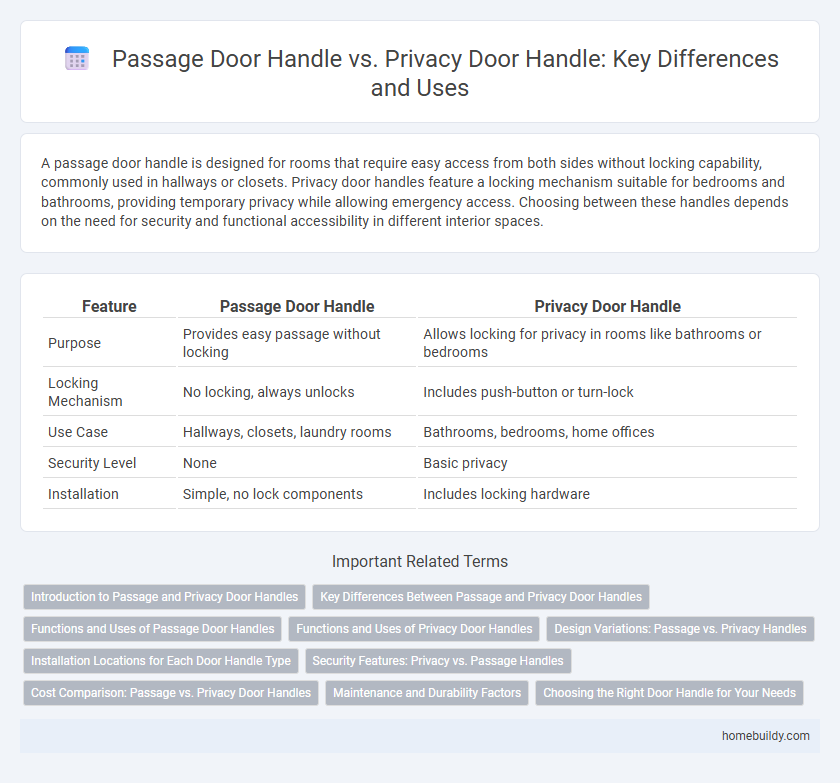A passage door handle is designed for rooms that require easy access from both sides without locking capability, commonly used in hallways or closets. Privacy door handles feature a locking mechanism suitable for bedrooms and bathrooms, providing temporary privacy while allowing emergency access. Choosing between these handles depends on the need for security and functional accessibility in different interior spaces.
Table of Comparison
| Feature | Passage Door Handle | Privacy Door Handle |
|---|---|---|
| Purpose | Provides easy passage without locking | Allows locking for privacy in rooms like bathrooms or bedrooms |
| Locking Mechanism | No locking, always unlocks | Includes push-button or turn-lock |
| Use Case | Hallways, closets, laundry rooms | Bathrooms, bedrooms, home offices |
| Security Level | None | Basic privacy |
| Installation | Simple, no lock components | Includes locking hardware |
Introduction to Passage and Privacy Door Handles
Passage door handles are designed for interior doors that require easy access without locking, commonly used in hallways or closets to allow free passage. Privacy door handles feature a locking mechanism suitable for bedrooms or bathrooms, enabling users to secure personal spaces while maintaining simple operation from the inside. Both types provide essential functionality tailored to different privacy and accessibility needs in residential and commercial settings.
Key Differences Between Passage and Privacy Door Handles
Passage door handles are designed for doors that do not require locking, commonly used in hallways and closets for easy access. Privacy door handles feature a locking mechanism, ideal for bathrooms and bedrooms where temporary privacy is needed. The key difference lies in functionality: passage handles provide free access without locks, while privacy handles offer a simple lock for privacy without the need for a key.
Functions and Uses of Passage Door Handles
Passage door handles are designed primarily for doors that don't require locking, such as hallway, closet, or utility room doors, offering easy access and smooth operation. Unlike privacy door handles, passage handles lack a locking mechanism, ensuring unrestricted passage while maintaining a streamlined aesthetic. Their functionality supports frequent movement between rooms without the need for security or privacy controls.
Functions and Uses of Privacy Door Handles
Privacy door handles are designed to provide security and confidentiality in rooms such as bedrooms and bathrooms by featuring a locking mechanism that can be engaged from the inside. Unlike passage door handles, which lack locks and allow free access between rooms, privacy handles prevent unauthorized entry while still allowing emergency access via an exterior release slot. Their primary function is to balance personal privacy with safety, making them ideal for residential and commercial settings where temporary but reliable room locking is required.
Design Variations: Passage vs. Privacy Handles
Passage door handles feature a streamlined design without locking mechanisms, allowing free movement between rooms and are commonly used in hallways and closets. Privacy door handles incorporate built-in locks or push-button mechanisms to secure bedrooms and bathrooms, blending functionality with sleek aesthetics. Both handle types offer diverse finishes and styles, enabling customization to complement interior decor while addressing specific access needs.
Installation Locations for Each Door Handle Type
Passage door handles are typically installed on doors that do not require locking, such as hallway or closet doors, allowing easy access and movement between rooms. Privacy door handles are designed for bedrooms or bathrooms where temporary locking is needed to ensure privacy without the need for a key. Installation locations for privacy handles often include interior doors where users require a simple locking mechanism, while passage handles are suited for open access points.
Security Features: Privacy vs. Passage Handles
Privacy door handles feature integrated locking mechanisms that secure rooms by preventing unauthorized access, making them ideal for bedrooms and bathrooms. Passage door handles lack locking capabilities, designed solely for smooth entry and exit, thus offering minimal security. Selecting between privacy and passage handles hinges on the need for controlled access versus unrestricted movement.
Cost Comparison: Passage vs. Privacy Door Handles
Passage door handles are typically more affordable than privacy door handles due to their simpler mechanism and lack of locking features. Privacy door handles often cost more because they include locking functions suitable for bedrooms or bathrooms, adding complexity and durability requirements. Choosing between the two depends on budget constraints and the need for security or privacy in specific rooms.
Maintenance and Durability Factors
Passage door handles feature simple mechanisms with fewer moving parts, resulting in lower maintenance needs and enhanced durability for high-traffic areas. Privacy door handles integrate locking components, which require periodic lubrication and inspection to maintain smooth operation and security, slightly increasing maintenance demands. Both types should use corrosion-resistant materials like stainless steel or brass to maximize longevity and withstand frequent use.
Choosing the Right Door Handle for Your Needs
Passage door handles are designed for areas where privacy is not required, such as hallways or closets, featuring a simple latch mechanism without locking capabilities. Privacy door handles offer a locking function suitable for bedrooms or bathrooms, providing security while still allowing emergency access with a release mechanism. Selecting the right door handle depends on the level of privacy needed and the specific room's purpose, ensuring both functionality and security are met.
passage door handle vs privacy door handle Infographic

 homebuildy.com
homebuildy.com